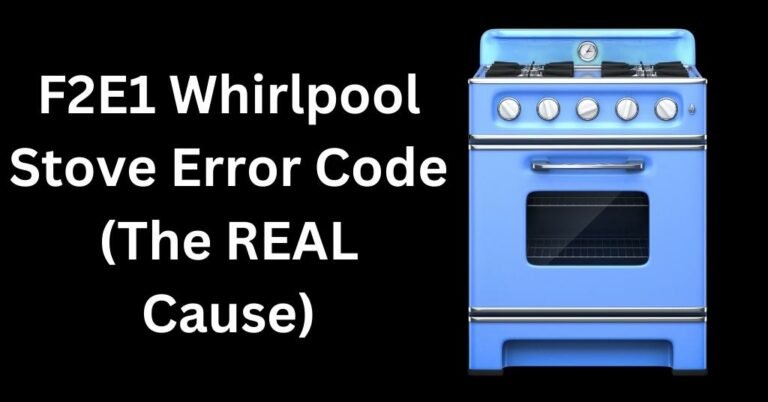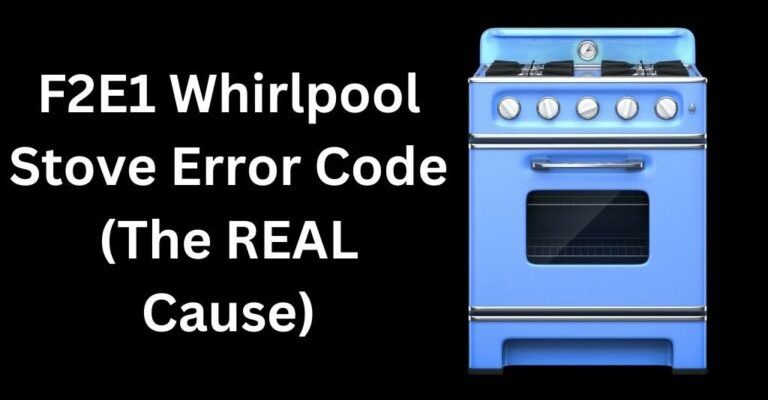
The thought of error codes might seem a bit intimidating at first, but understanding them is much like unlocking the meaning of a cryptic emoji from a friend. The E1 error code is pretty much your oven’s way of saying, “Hey, there’s something up with my temperature sensor!” It’s like when you’re feeling under the weather and need a thermometer to check if you have a fever. This code indicates that there could be an issue with your oven’s internal thermometer – also known as the temperature sensor. Ignoring it might lead to more than just a culinary mishap; it could affect the performance of your oven in the long run.
Understanding the E1 Error Code
Here’s the deal: error codes like E1 show up to inform you about specific issues. On Whirlpool ovens and ranges, an E1 error specifically points to a problem with the temperature sensor. Consider the sensor like the nerve endings in your fingers when you touch something hot. If they’re not functioning properly, you won’t accurately know the temperature of the surface. Similarly, if the oven’s sensor isn’t working right, the oven can’t maintain or display the correct temperature.
Imagine you’re baking cookies, and the oven thermometer isn’t giving the accurate temperature. Your cookies might end up too crispy or undercooked – not ideal! The E1 code is your oven saying, “I can’t guarantee perfect results without my temperature gauge working right.” So while it might not seem like a major issue right away, ignoring it could lead to inconsistent cooking results over time.
Understanding these signals is essential because, left unchecked, they can lead to bigger issues. Over time, a faulty sensor might not just lead to imperfect meals, but it could strain other components of the oven due to overheating or underheating, leading to expensive repairs down the line.
Steps to Address the E1 Error Code
Before you start worrying about calling in the repair cavalry, here’s what you can try at home. First and foremost, a simple reset might do the trick. Just like when your smartphone acts up and a restart fixes it, turning off the oven at the circuit breaker for a minute and then turning it back on may clear the error if it’s a temporary glitch.
If the reset doesn’t work, it could indicate that the sensor needs more attention. The temperature sensor in many Whirlpool models is accessible from inside the oven. It typically looks like a thin metal rod and is usually attached with a couple of screws. Before you start any DIY repair, make sure to unplug the appliance for safety reasons. You don’t want to end up in a shocking situation while trying to fix it!
If you’re comfortable with handling basic tools, you could check the sensor’s connection and look for apparent wear and tear. Sometimes, tightening loose connections can make all the difference. But if you find that the sensor looks damaged or burnt, it might be time to replace it. Replacement sensors are generally available from appliance parts stores, and most come with installation instructions.
When to Call a Professional
Now, you might be wondering, “What if I’m not the DIY type?” Well, there’s no shame in calling the pros! If your attempts to reset or inspect the sensor haven’t resolved the error, or if you’re just not keen on taking apart your oven, it’s time to contact a professional technician. They have the proper tools and expertise to handle such issues safely and efficiently.
Sometimes, the E1 error might be a symptom of a more complicated internal issue, such as a malfunctioning control board. In such cases, a technician’s expertise is crucial because they can perform diagnostic tests that aren’t possible for most of us at home. They’ll be able to pinpoint the exact problem, ensure all components are safe and functional, and replace or repair anything necessary.
In the meantime, while you wait for professional help, try to avoid using the appliance to prevent any additional problems. Yes, waiting might be a hassle, but it’s always safer to play it cool, literally and figuratively, than risk further damage.
Preventive Tips to Avoid Future Issues
Now, let’s chat about keeping your appliance healthy. Just like regular check-ups with a doctor can prevent health issues, routine maintenance can ward off most common problems with appliances. To keep your Whirlpool oven in tip-top shape, consider making it a habit to clean it regularly, checking the condition of the seals and doors, and inspecting the connections and wires for any signs of wear and tear.
Another handy tip is to keep an eye on how your oven behaves. If you notice it’s not heating as quickly as it used to, or it’s not maintaining temperature, these could be early signs of sensor issues. Addressing these small glitches early on can prevent the E1 from appearing at all.
In addition, try to avoid power surges in your home, as these can lead to errors in electronic appliances. Using a surge protector can be a wise investment, especially during stormy seasons when power fluctuations are common.
So, while you can’t completely eliminate the chances of a pesky error code showing up, with a bit of care and attention, you can certainly minimize the occurrence and keep your appliance running smoothly for years to come. Remember, being proactive with maintenance is not just about avoiding inconvenience; it’s about extending the lifespan of your beloved kitchen helper.
